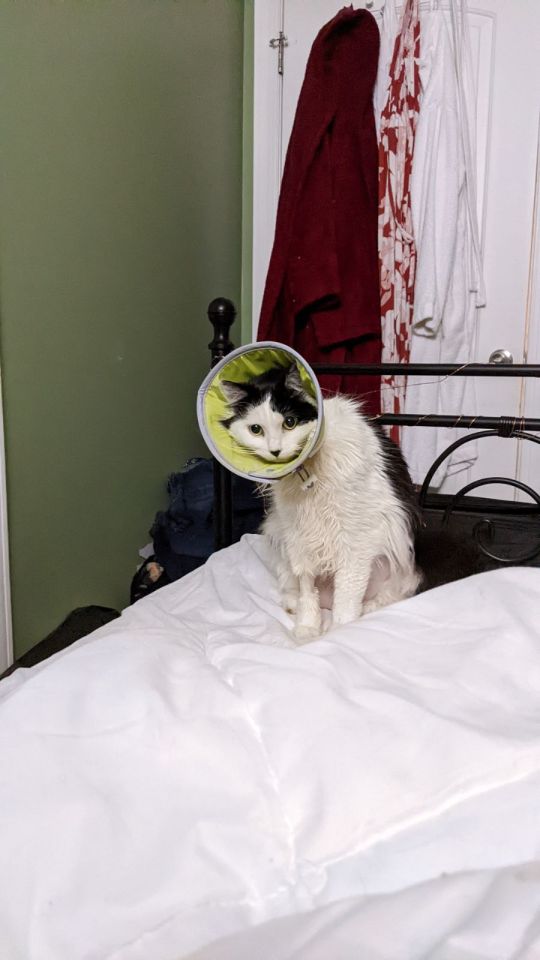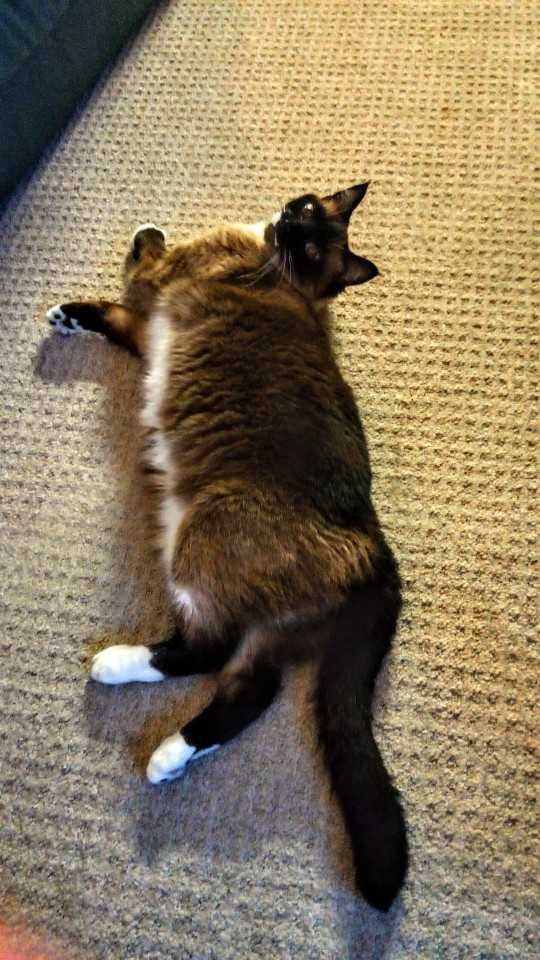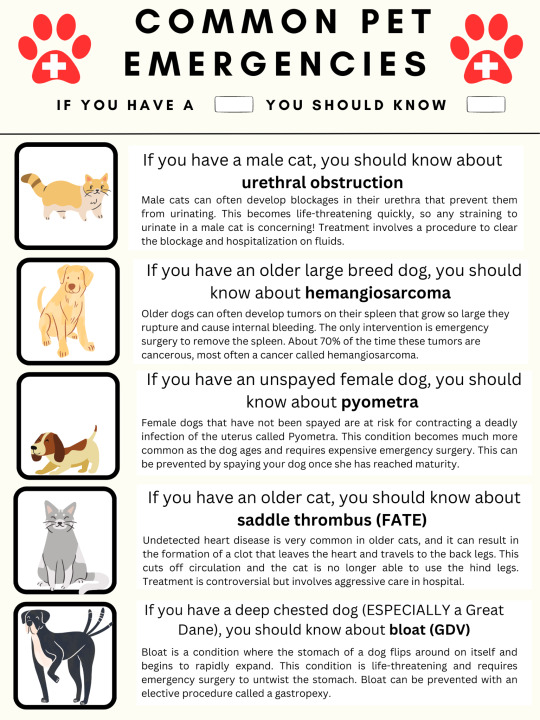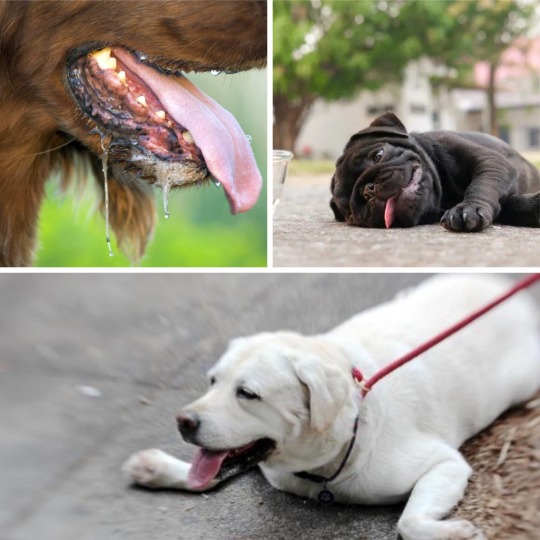#veterinary emergency
Explore tagged Tumblr posts
Text
PET EMERGENCY DONATION POST
More information on the twitter thread i made as it happened last night HERE
to put it simple because my hands are not doing great and I can't type much; my youngest cat, nu, is having a veterinary emergency and the solution is to have her spayed immediately / as soon as possible. im asking for help in a really sudden and desperate situation because i have no income as im disabled, i can offer art and voice acting in exchange for help but please anything helps please share or donate anything helps im genuinely terrified i don't want her to suffer at all
donation link here
#grim.txt#donation post#pet fundraiser#donations needed#please help#veterinary emergency#signal boost
29 notes
·
View notes
Text
GoFundMe Link
Hello fellow humans and thank you to the buds who have donated!
Last Tuesday, this little gremlin:

...Had a mass of things she should not have eaten surgically removed from her intestine. Another six hours without surgery and she would have died.
She spent two nights at the emergency vet, and my household now has $6,000 worth of debt about it. (Down from 8k, thank you thank you thank you.)
@taraljc is a freelance graphic designer, I am a freelance copywriter, and our combined income is not great.
And, unfortunately, the nature of the debt makes it particularly imperative to pay it down quickly. It is of a nature that makes everyone's lives absolutely miserable until the debt is gone.
The number on the GFM is also not representative; as we're reusing an existing GFM from last year for out of spoons reasons. Housing insecurity, amirite?
The amount raised so for this far for this fucking disaster of a week is roughly $2,000? and a bit?.
Spending breakdown:
Debt repayment $2,000
Cat post-op supplies, transportation to and from the emergency vet, a little food in line with our spoons count: ...and a bit. 😔
Debt remaining: $6,000
I know everyone is probably spent out and donated out but if you see this I would personally appreciate it if you would reblog the post instead of liking the post. Get more eyeballs on it.
GoFundMe Link
28 notes
·
View notes
Photo

Want to help Minmo grow strong and healthy? Then please consider donating to help out my sweet child! Can't/don't want donate? Then just sharing around is more than enough to help! Full details can be found here as well.
https://gofund.me/36794690
Tldr Minmo’s been to the vet twice, third time will be today. She’ll have an x-ray at the least which is more expensive than the last two visits. Will possibly need further treatment. I am a disabled person living off of disability payments alone which are far below the poverty line, making it hard to get by day to day without any extra expenses.
#animal help#animal care#animal welfare#animal wellbeing#veterinary bills#vet bills#veterinary costs#veterinary expenses#vet costs#veterinary emergency#vet emergency#vet expenses#pet care#pet help#pet wellness#low income#below poverty line#disabled#persons with disabilities#pwd
21 notes
·
View notes
Text
It feels a little awkward and vulnerable to come out of my internet hibernation to ask for help, but I've seen the kind of reach tumblr can have.
My pretty boy became sick and needed hospitalization this month. While he is now luckily at home and slowly recovering, the veterinary costs were as astronomical as they often are. I live in a state with an incredibly high cost of living, and paying off the cost of his treatment - alongside everything he'll need to avoid a reoccurrence of hospitalization in the future - is actively impacting my ability to afford rent, let alone costs for utilities, food, and my own monthly medicine.
I have a full invoice and cost breakdown linked at the GoFundMe and will provide updates/proof of payment as funds are acquired. We are both deeply grateful for any help at all and I appreciate you even reading this post.
9 notes
·
View notes
Text
Scout found a snake in the back yard. I couldn’t see the bite so I couldn’t understand why her leg was swelling and she was chewing it. Doctor says it wasn’t a poisonous snake, which makes sense since she’s still alive. She doesn’t want to smile for the camera right now. Yeah, that’s my foot. That’s not my hair on the carpet.

10 notes
·
View notes
Text
Nothing like ending the day with a little goat kid attacked by a dog. 🙏 he made it through the night and is on the mend this morning!
12 notes
·
View notes
Photo

Digital artist available. Fanart, fantasy, DnD, OC, and more. I've opened commissions to help pay for my cats veterinary expenses. 🐱 Please DM me for more details.
#digital art#commissions info#commissions open#art commissions#fantasy character#fanart#original character#dnd character#illustration#cat lovers#veterinary emergency
6 notes
·
View notes
Text
THANK YOU OP. I’ve worked in the vet field for years and I’ve seen every one of these conditions devastate multiple families, including my own (lost a very dear old cat to a FATE.)
Pyometra especially gets me since its so easy to prevent and so few people know about it.
One of the hardest things about working in a veterinary ER is delivering bad news. I feel like at least once a shift someone is blindsided by their pet being diagnosed with a condition they’ve never heard of before. In many cases this is unavoidable but I really feel that some of the most common critical emergencies I see would be easier for owners to process if they had prior knowledge about the illness.
The following infographic is far from a comprehensive list and truthfully I have a LOT more to say about diagnosis, prevention, and treatment of each of these conditions. However, this image shows just a few of the major points that I wish owners had been able to prepare for prior to hearing about them in the ER. Some of these conditions are preventable and some are not but they all require an owner to make difficult decisions in a crisis situation. If your pet fits into one of these categories, please just do a quick google about the condition, and maybe discuss with your vet signs that you can watch for at home.

12K notes
·
View notes
Text
Neoplasia pode causar sepse?
A sepse devido à quimioterapia ou neutropenia relacionada ao câncer é uma das emergências mais comuns tratadas na medicina oncológica.
Em humanos, a sepse é uma causa comum de morte em pacientes com câncer, excedendo todas as outras causas combinadas.1-7 À medida que a popularidade de cães e gatos aumenta e o uso de quimioterapia e radiação aumenta na prática privada, é provável que esta observação se repita. na medicina contra o câncer canino e felino. Como cães e gatos tendem a esconder seus sintomas até o final da doença, a condição de sepse pode estar bastante avançada quando reconhecida pela primeira vez e requer intervenção imediata da equipe de saúde canina e felina.
A neutropenia secundária a malignidade ou mielodisplasia, ou como resultado dos efeitos mielossupressores da quimioterapia ou radioterapia, é um fator predisponente comum para o desenvolvimento de sepse em cães e gatos. Choque séptico é o estado de colapso circulatório que ocorre secundário a sepse e/ou endotoxemia avassaladoras. Esta síndrome é frequentemente fatal, com uma taxa de mortalidade de 40% a 90%.
A seguir estão os fatores predisponentes para sepse associada à neutropenia:
A neutropenia pode ser causada pelos efeitos mielossupressores da quimioterapia. Os efeitos mielossupressores dos agentes quimioterápicos podem ser categorizados como altos, moderados ou leves. Esses medicamentos causam um nadir (parte mais baixa da contagem de glóbulos brancos) em momentos diferentes após a administração).
Cães e gatos esplenectomizados são suscetíveis a sepse avassaladora quando infectados com uma cepa de bactéria encapsulada contra a qual não produziram anticorpos.
Cateteres vasculares ou urinários de demora têm sido associados a um aumento na prevalência de sepse. Quanto mais tempo o cateter estiver presente, maior será a probabilidade de infecção, especialmente em cães e gatos neutropênicos.
A aquisição frequente de amostras de sangue aumenta muito o risco de sepse em cães e gatos com câncer.
A hospitalização prolongada pode resultar em consequências graves, em parte porque o paciente está continuamente exposto a cepas bacterianas resistentes aos antibióticos mais comumente utilizados nessa prática.
A desnutrição é uma causa grave de debilitação e diminuição da resistência a infecções bacterianas, especialmente em cães e gatos com neutropenia.
Cães e gatos com disfunção neurológica ou pacientes que não deambulam por qualquer causa também apresentam risco aumentado de sepse.
Sempre que possível, estes fatores de risco devem ser evitados ou minimizados e os problemas associados devem ser reconhecidos e corrigidos precocemente para reduzir a probabilidade de sepse.
Defeitos na imunidade celular são causa de sepse em cães e gatos com câncer. A disfunção imune celular, embora extraordinariamente difícil de diagnosticar em cães e gatos, pode ser devida a uma causa subjacente ou ao resultado da administração de agentes antineoplásicos e/ou corticosteróides. Esses defeitos podem resultar em várias infecções bacterianas, micobacterianas, fúngicas e virais. A disfunção imunológica humoral também está associada a um aumento da prevalência de sepse em pacientes humanos com câncer e pode causar problemas semelhantes em animais. Cães e gatos agamaglobulinêmicos ou hipogamaglobulinêmicos são suspeitos de serem suscetíveis a infecções. O mieloma múltiplo e a leucemia linfocítica crônica são neoplasias comuns associadas à disfunção imunológica humoral em pessoas e também são causas prováveis em cães e gatos.
Fonte:
Gregory K. Ogilvie. Care Beyond a Cure: Oncologic Emergencies--Help!!!! World Small Animal Veterinary Association World Congress Proceedings, 2005 . Disponível em: <Care Beyond a Cure: Oncologic Emergencies--Help!!!! - WSAVA2005 - VIN>
#sepse#small animal veterinary medicine#veterinary emergency#neoplasia#veterinary oncology#dogs#cats
0 notes
Text
Heatstroke in Dogs: "How hot is too hot?"

Heatstroke is a life-threatening emergency when your dog's body temperature becomes too high and cannot be cooled effectively. Early detection and aggressive therapeutic intervention is required to increase the chances of survival, as well as avoiding secondary complications.
Initial symptoms may include:
Panting, Increased thirst --- indicating heat stress; a dog is still generally alert and ambulatory
Hypersalivation or foaming at the mouth, Weakness and/or collapse --- indicating progression to heat exhaustion; a dog may become non-ambulatory and although still mentally aware, may be too tired to react or get up

Heatstroke then occurs when a dog cannot regulate their body temperature, and it rises to 105 degrees F or higher.

Dogs who are elderly, obese, have thick and/or dark-colored coats, shortened muzzles (i.e. brachycephalic breeds), or pre-existing heart or respiratory conditions are at heightened risk for heatstroke.
If a dog's temperature remains elevated for too long, severe damage will begin to occur to the organs ---
Gastrointestinal: GI dysfunction will occur from inadequate blood supply and poor perfusion throughout the tract, which may then result in vomiting and/or diarrhea +/- blood.
Cardiac: Blood vessels will dilate and cardiac output increases, leading to the redistribution of blood flow and widespread hypoxia. This may then cause ventricular arrhythmias and ultimately, heart failure.
Neurologic: The brain will start to swell and bleed in certain areas, resulting in seizures, nystagmus (rapid eye movement), anisocoria (uneven pupil sizes), or even coma.
Renal/Hepatic: Kidney and liver failure result from decreased perfusion, hypoxia, and tissue damage. Even if a dog recovers from heatstroke, the kidneys and liver may have permanent damage that will require lifelong treatment.



Other complications from heatstroke may include:
Disseminated intravascular coagulation (DIC)
Systemic inflammatory response syndrome (SIRS)
Multiple organ dysfunction syndrome (MODS)
Rhabdomyolysis

With all of this in mind, heatstroke can be very serious and warrant an ER visit +/- hospitalization. Treatment will involve strategically cooling your pet and intensive care to avoid the secondary complications described above, and death. This might include IV fluids, GI protectants, antibiotics, oxygen therapy if your pet is in respiratory distress, and various other medications to treat cardiac and metabolic dysfunctions. In more severe cases, a dog may even require a blood/plasma transfusion. Length of hospitalization will depend on the pet's response to treatment and can range anywhere from 24 hours to weeks, if complications arise.
In the event heatstroke in a dog is suspected, owners should make every attempt to begin cooling as they transport to a veterinary facility - wetting their fur with cool (not ice cold) water, driving with the windows down (or air conditioning at its maximum capacity) can make all the difference. Studies have shown that pets who are actively cooled down before being taken to a hospital are ~2.5x more likely to survive heatstroke compared to those who are not.
youtube
Unfortunately, many dogs continue to die every year from heat-related causes - or are euthanized when there is a lack of funds for their treatment, or simply very poor prognosis. Measurements need to be taken to spread awareness about heatstroke and advocating for its prevention in our pets.


For more tips on how to keep your pet cool during heatwaves, read my other post - "5 Tips on How to Keep Your Dog Cool".
Sources/Further Reading:
Cohen, Aly. “Heatstroke: A Medical Emergency.” Cornell University College of Veterinary Medicine - Riney Canine Health Center, Canine Health Information.
Flournoy, W. Shannon, et al. “Heatstroke in Dogs: Clinical Signs, Treatment, Prognosis, and Prevention.” Compendium: Continuing Education for Veterinarians, vol. 25, no. 6, June 2023.
Hall, Emily, et al. “Dogs Don’t Die Just in Hot Cars—Exertional Heat-Related Illness (Heatstroke) Is a Greater Threat to UK Dogs.” Animals, vol. 10, no. 8, 31 July 2020, https://doi.org/10.3390/ani10081324.
Magazanik, A., et al. “Tap Water, an Efficient Method for Cooling Heatstroke Victims - a Model in Dogs.” Aviation, Space, and Environmental Medicine, vol. 51, no. 9, 1 Sept. 1980.
Newfield, Amy. “Providing Care for Dogs with Heatstroke.” Today’s Veterinary Nurse, 16 May 2019.
Tabor, Brandy. “Heatstroke in Dogs.” Today’s Veterinary Practice, 2014.
#heatstroke#veterinary medicine#canine#veterinary#heat exhaustion#heat safety#pet products#veterinary emergency
1 note
·
View note
Text
My friend’s dog is currently being treated at our local emergency animal hospital and any donations would make a huge difference in helping with the large cost of vet bills. Please consider helping out if you can 🫶🏻
0 notes
Text


Looking like cats! Three weeks old tomorrow!
#pets#veterinary#foster kittens#kittens#frogs and bunny#bottle babies#had a trip to the emergency vet today but everyone is fine now
3K notes
·
View notes
Text
PLEASE HELP IF YOU CAN
Please help me if you are able, my cat, my boy duggie, has a lump on his side that is clearly infected and bothering him. It's oozing puss and feels so swollen. Where I live there are only 3 vet offices and none of them are cheap. The lowest one is 159usd for an exam. If you can spare even a little please help. Paypal: @ Goatsgalore96 Venmo @ CallenGGoat Cashapp: $calgoat96

#emergency#veterinary#cat health#donations#emergency donations#cats of tumblr#mutual aid#financial aid#Please i cant let him hurt like this#i dont know what else to do
178 notes
·
View notes
Text
Please, help me save my Rudy.
This is my pet, Rudy. She got hit by a bus a couple days ago and needs tests and surgeries that are too expensive for me and my family alone.

This was Rudy yesterday. She's awake and may look alright but all the problems she has are on the inside.
We can't have her home (she needs surgeries) and she hasn't been able to sleep without the meds unless we visit her. She even fell asleep in my mom's hand.
Please help us with anything. I'll be eternally grateful.
Shares are very appreciated too.
There's more info in the link down here:
Please, help me save my Rudy.
#tw: blood#emergency#gofundme#please#pets#my pet#animals#please reblog#pinscher#donations#emergency donations#vet#veterinary#surgery
87 notes
·
View notes
Text
URGENT ‼️ PLEASE READ
recently I rescued a cat and we were not expecting her to be in the condition she is in. she was rescued from a very neglectful situation in which we believed she would just need a check up and a groom; however, that was not the case.
meet bear: my sweet sweet kitty who is in urgent need of not only a much needed bath, but immediate medical care as well. in order to see a groomer to get her overgrown nails and matts taken care of (which have poop embedded into them as well), she needs to see the vet first for a plethora of issues.
first she has never been to a vet so she has never had her shots before (which are necessary in order to get groomed due to being a danger to people)
second she has bitten someone and given them blood poisoning due to the bacteria in her mouth from said neglectful living situation. this could be resolved with a dental checkup.
third, she likely has a head cold because she's having issues breathing. she's coughing and sneezing and I hear her huffing when she eats. she also is producing a lot of saliva despite potentially being dehydrated (which brings a risk for crystals as well)
fourth her sister has died of pyometra and bear is not spayed, so after her check with the vet and being groomed, we also need to discuss a future spay.
unfortunately her appointment isn't until June 10th, however she needs to see a vet now which means I may need to bring her to an animal hospital (since the vets are all booked up atm) which tend to be more expensive than doctor visits.
if you would like to help, PLEASE share this post or consider commissioning me. my information can be found on my website here:
https://batpoisonzcommissions.carrd.co/
everything made from here will be used to help my cat bear get the care she needs.
#mspec queer#mspec lesbian#lesboy#turigirl#bisexual#pansexual#bear#cat#emergency#emergency commissions#urgent#veterinary#kitty#furry#commissions#art#digital artist#artwork#artist#lesbian#mspec safe#gay#lgbt#bi lesbian#lgbtq+#bi lesboy#mspec lesboy#lgbtq#aro#art trade
58 notes
·
View notes
Text
Hey folks,
My oldest kitty has to go in for a very expensive ultrasound tomorrow to try and determine the cause of the accidents & diarrhea he's having, and pet insurance won't cover it.
I don't have the bandwidth between school, work and stress to add more commissions to my work load so I have to ask for donations to help cover the bill.
Anything helps. Please reblog.
21 notes
·
View notes